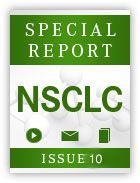Lung Cancer Research Shows Distinct Genomic Differences in Younger Patients
A recent study demonstrated that specimens from patients with lung cancer under the age of 50 years appear to be enriched with molecular alterations that are amenable to targeted treatment.
Lung Cancer Research Younger Patients

Geoffery R. Oxnard, MD
A great deal of research has been put forth toward studying how to treat and optimize outcomes in the older, less fit patients with lung cancer; however, a recent study1demonstrated that specimens from patients under the age of 50 years appear to be enriched with molecular alterations that are amenable to targeted treatment. These findings have implications for expanding the use of genomic testing (and thereby potentially increasing treatment options) for the younger lung cancer population.
An Increase in Targetable Genetic Alterations
The study of 2337 eligible patients with nonsmall cell lung cancer (NSCLC) and tumor genotyping results included some 81 patients (4%) who were diagnosed at age 40 years or younger. There was an increased likelihood ofEGFRkinase mutations (P= .02) andALKrearrangements (P<.001) in patients diagnosed with NSCLC at a younger age. Nonsignificant trends for younger age at diagnosis were also found forROS1(P= .10) andERBB2(P= .15).
For those who had undergone testing for all five targetable alterations (n = 1325) the likelihood of harboring a targetable mutation was increased with younger age at diagnosis (P<.001). The significant association was retained in multivariate analysis controlling for smoking status, female sex, and Asian race (P= .006).
Further analyses using age cut points showed that there was a 59% increased likelihood of detecting a targetable alteration in patients under 50 versus an older patient.
Notably, however, the prognosis was equally poor for the youngest age group (under 40), with a median overall survival (OS) of 21.4 months, and for those over 70 years of age (median OS, 22.3 months); thus the findings suggest an important combination of opportunity (by way of targetable alterations) and risk (by way of equally poor outcome) in this younger lung cancer population.1
“It took 10 years of experience here to collect together a pretty small cohort, but compared with the rest of the cohort, we were able to see some trends” said Geoffery R. Oxnard, MD, a medical oncologist at the Dana Farber Cancer Institute and corresponding author on the paper, in an interview withTargeted Oncology.
“Anecdotally, we think young people must be different, but it’s not been shown, scientifically, that young lung cancer is an outlierthere actually has been a lot more [focus on] how do you treat elderly patients differently; how do you be more delicate with the elderly; and what is the definition of elderly—that’s sort of where the focus has been in lung cancer care, but we’ve not really said what counts as a young lung cancer patient, and how the young lung cancer patients are different, so I think this is new in that regard.”
Why Study Young Lung Cancer?
Other cancers, such as breast cancer, have typically seen younger patients have unique genetics, and follow a more aggressive clinical course, and Oxnard notes that this was, in part, the impetus for conducting the study.
“There are other diseases where we think that young means different biology and that was the hypothesis we wanted to test here. Like with breast cancer, we asked, ‘Is there a genetic difference in these [younger] patients, and outcomes-wise, and is there a difference in how they do?’ That’s what we foundthey are genetically different—enriched for these potentially very treatable genetic alterations—and yet they [the patients] clinically don’t do better. We would think that they would live longer, be able to capitalize on these genetic alterations, be more fit, and have the best outcomes, but instead, their outcomes seem to mirror the outcomes of the oldest, least healthy lung cancer patients. My conclusion is that this is a vulnerable population that deserves increased attention. This is a population where we can make a big difference, I think, by giving them better genomically-targeted therapies, and what that requires is diligence to find the ‘secret’ genetic alteration that explains their cancer.” Oxnard emphasized that, in some instances the patient’s oncogenic driver could be one of the well-known targetable alterations (eg,ROS1, ALK), but in other cases, there may be unique and/or rare molecular alterations that must be more rigorously sought.
“The patient that motivated this study was a patient in his 30s, who came to see me years ago. He was young, he’d never smoked, and he didn’t fit.” After finding nothing with standard testing, Oxnard said they then performed next-generation sequencing (NGS) on the patient, and found an insertion inFGFR2, a mutation they’d never heard of before, subsequently leading this patient to a first available trial with an FGFR inhibitor.2Although the treatment was ultimately unsuccessful, Oxnard noted “...this young lung cancer patient was the nidus for discovery efforts, to learn a new oncogene, and to find new drugs for this oncogene. And so, in those lung cancer patients where you don't find anything with the first pass of testing, I think that that’s an opportunity for discovery. Those are patients where, if we look deep enough, we can find that link, and then start working on finding the treatments.”
Could NGS Make a Difference in Young Lung Cancer?
Asked what the implications of the current findings might be for genetic testing, Oxnard said, “This was not a study of whether next-generation sequencing makes a difference for young lung cancer; this was a study asking (using the available technologies over the past 10 years and focusing on the key, well-described genes) whether we could see important trends that need deeper investigation. In our current nomenclature, we’ve talked about Asian race, smoking status, gender, and histology, as the four fundamental clinical characteristics that we should be considering when we think about likelihood for enrichment for a genomic alteration… I think these data suggest that age needs to be one of those fundamental characteristics we incorporate when we think about the value of genomics. Young age is not currently a standard part of our nomenclature or part of our risk assessment, and I think it should be.”
Oxnard also described the Genomics of Young Lung Cancer Study (NCT02273336) as an important next step in furthering the understanding of young lung cancers.3“Partly motivated by data we have a study, led by Barbara Gitlitz, MD, at USC and myself, which is now enrolling remotely and internationally, with the support of Addario Lung Cancer Medical Institute and Foundation Medicine. Young lung cancer patients around the world can go to the study website, express their interest in the study, consent, submit tissue for testing, and submit data about their characteristics as a young lung cancer patient, risk factors, etc. It’s an opportunity to look at epidemiology, and then, for those that have not had a genomic alteration identified with standard testing, next-generation sequencing is offered for free to try to identify what’s going on and connect them with a targeted therapy.”
Oxnard believes the results of the current study, as well as the Genomics of Young Lung Cancer Study could serve as a basis to further refine and individualize treatment plans. “This data needs to help us change the narrative about lung cancer. The narrative that lung cancer is caused by smoking, and when we stop smoking, lung cancer will go away, was very effective over the past couple of decades, but it’s become a lot more nuanced now. When you see an 18-year-old with lung cancer, and I’ve seen that, it makes you realize that the dominant narrative, and the stigma associated with that narrative, needs to be modified.”
Oxnard notes that there is a lot of optimism, and a kind of “next-generation sequencing for all” mentality that exists right now. “I’m sure there are a lot of companies that want us to think that’s the answer, and I think that might be true, but [there is] no question that every young lung cancer [patient] needs next-generation sequencing; no question that it’s indicated and needs to be reimbursed by insurance. This is a group where we can make a difference.”
References
- Sacher AG, Dahlberg SE, Heng J, Mach S, Jänne PA, Oxnard GR. Association between younger age and targetable genomic alterations and prognosis in non-small cell lung cancer. JAMA Oncol. 2015:1-8.
- Tanizaki J, Ercan D, Capelletti M, et al. Identification of oncogenic and drug-sensitizing mutations in the extracellular domain of FGFR2. Cancer Res. 2015;75(15):3139-3146.
- Addario Lung Cancer Medical Institute. Genomics of Young Lung Cancer Study. https://www.openmednet.org/site/alcmi-goyl. Accessed January 4, 2015.
